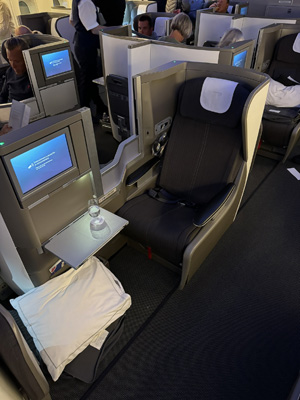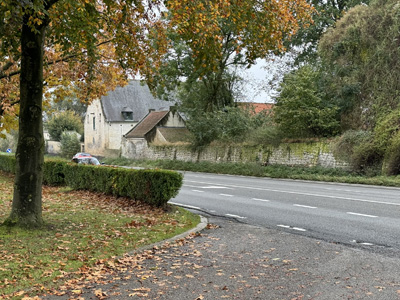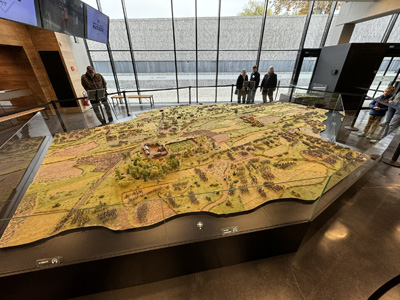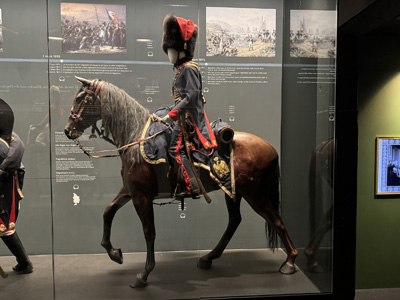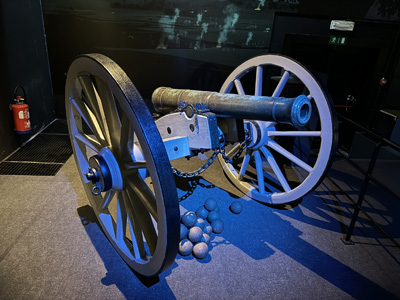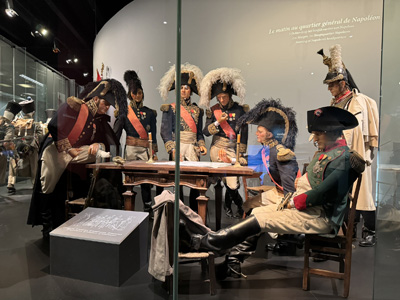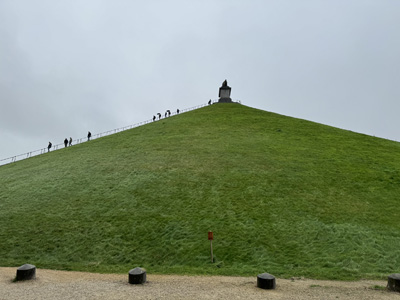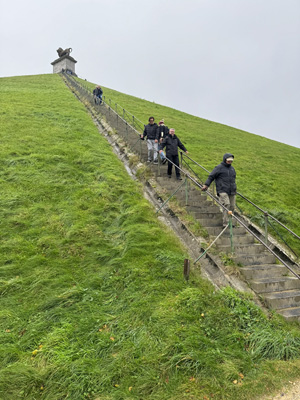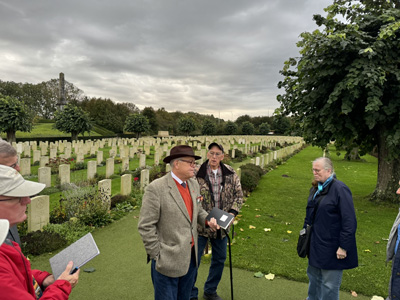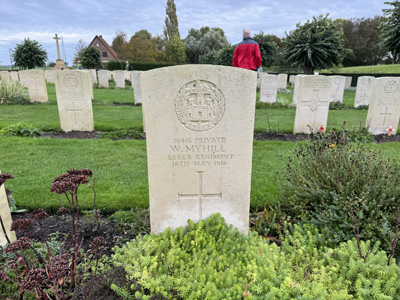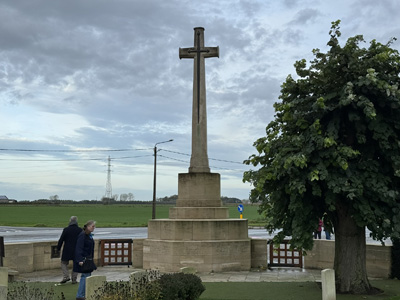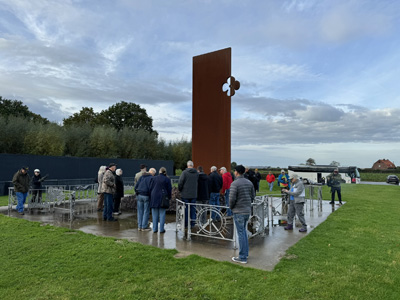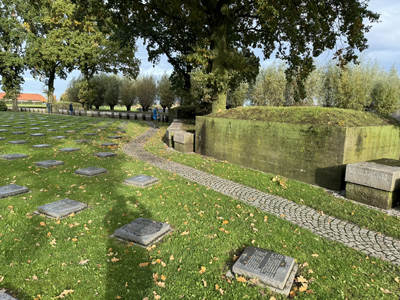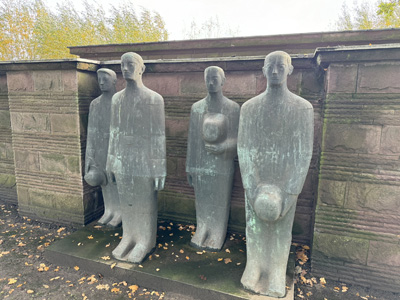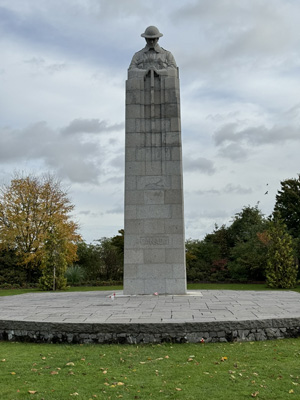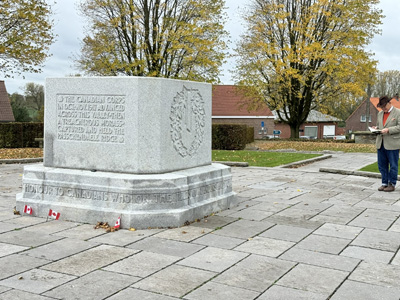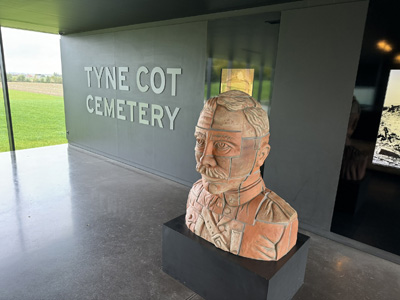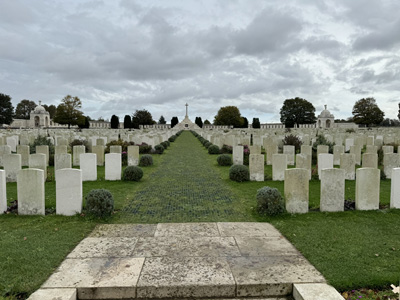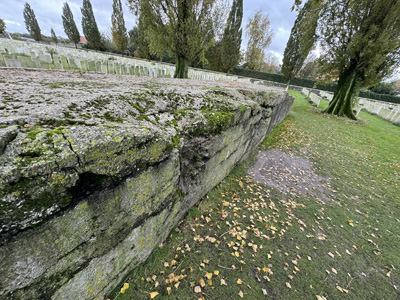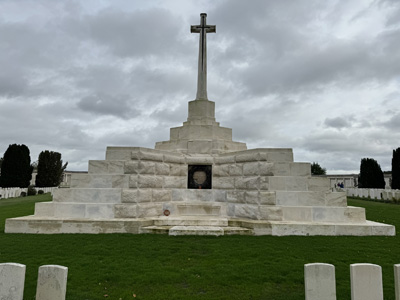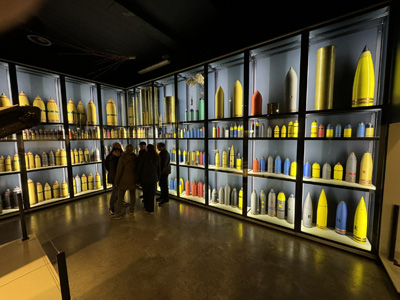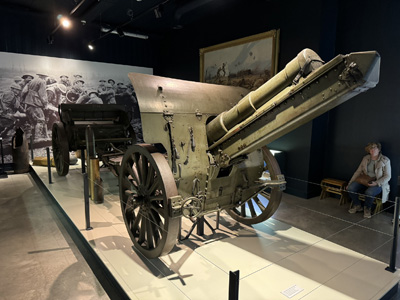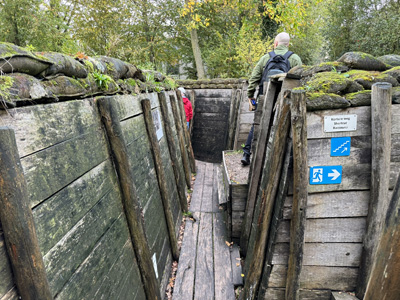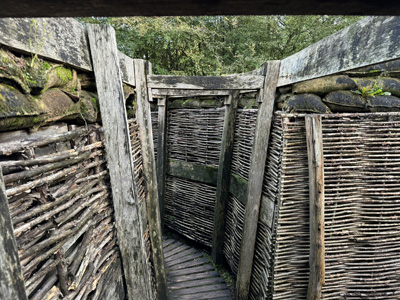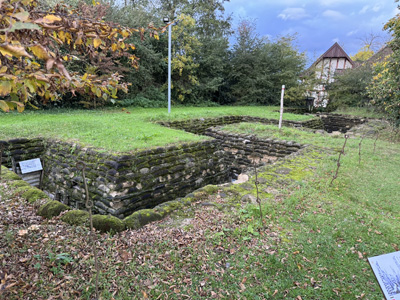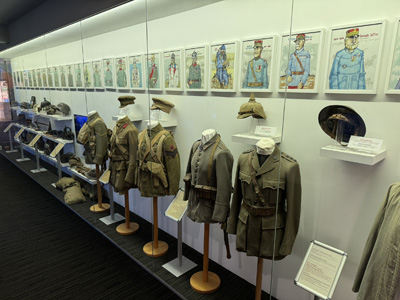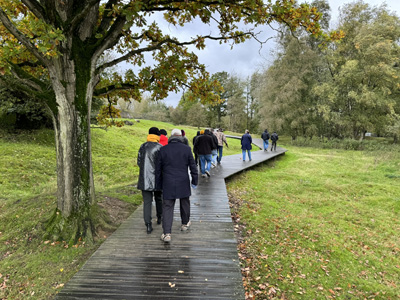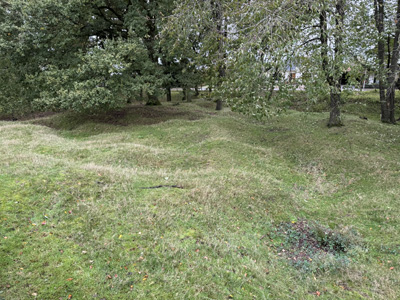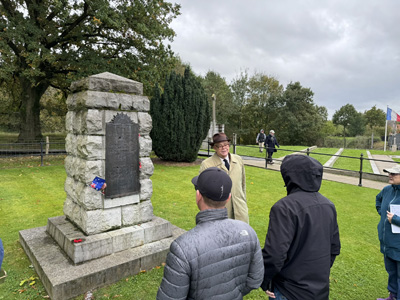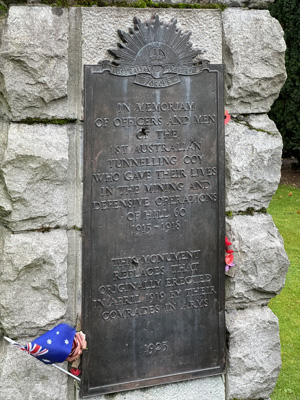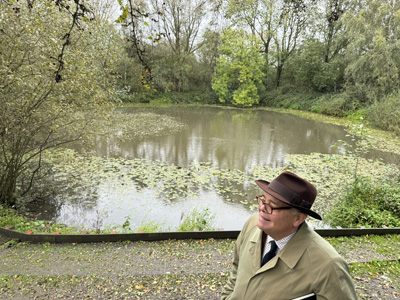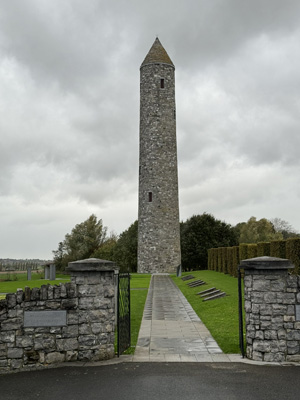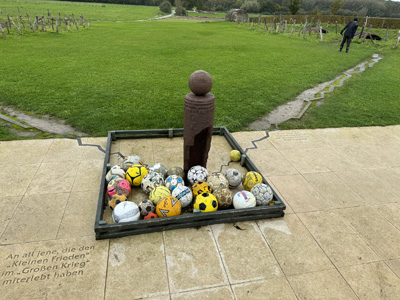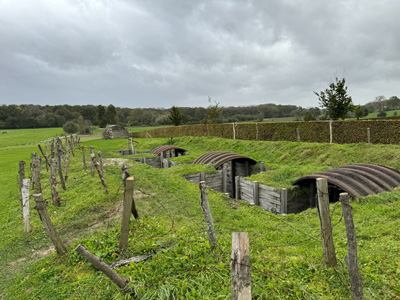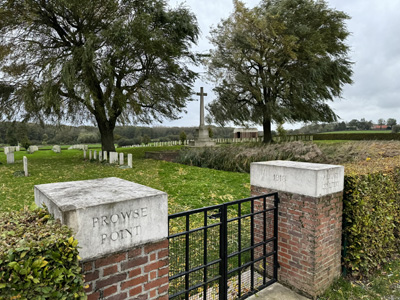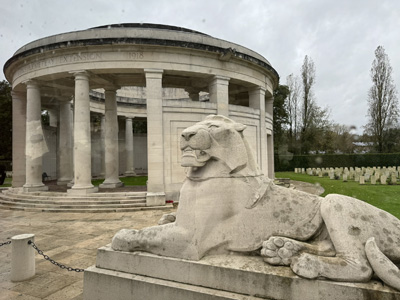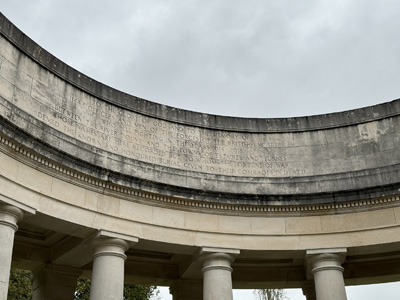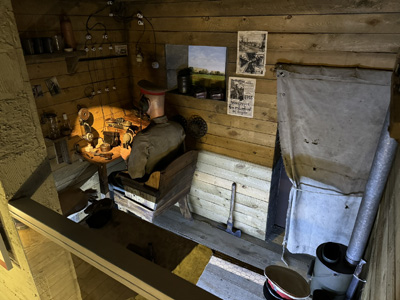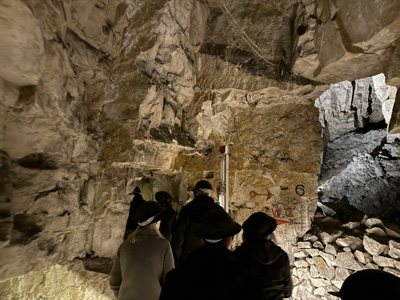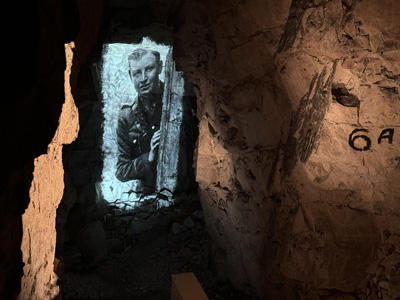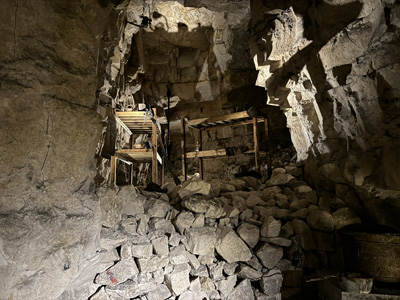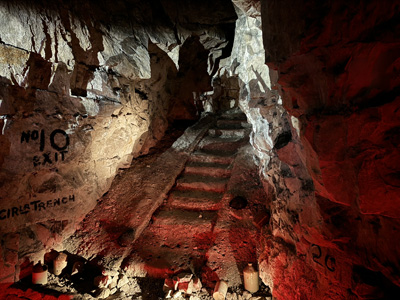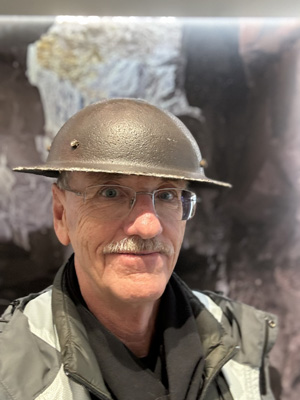Hal Jespersen's World War I Tour, November 2023
This is my (Hal’s) report on my trip to Belgium and France for a tour of the World War I Western Front, hosted by Stephen Ambrose Historical Tours. It is my third tour with Ambrose, the first being the 75th anniversary of D-Day in 2019, followed by Patton’s advance across France and Belgium to Germany, then the Italian Campaign from Sicily to Rome. Those travelogues are here and here. Because this report is so large, I have broken it into three parts:
- Part 1: London, Brussels, Waterloo, Ypres, Arras (this page)
- Part 2: Vimy Ridge, Cambrai, The Somme, Chemin des Dames, Reims, Compiègne
- Part 3: Château Thierry, Belleau Woods, Verdun, Meuse–Argonne, Meaux, Paris
Saturday, October 28 — to London
I started by taking an overnight flight to London on British Airways, reaching London Heathrow midafternoon. [Rant: This was my first experience with BA A380 business class and I was not impressed. The almost-lay-flat seat was about four inches too short for me and was fully exposed to the aisle. There was little storage or shelf space. The power and USB outlets were flaky. Because of the late evening departure, I went directly to sleep and did not eat on the flight, either dinner or breakfast, except for coffee.] While in the air, Europe went back to standard time, a week earlier than the US, so there is only a seven hour difference between California and England.
Sunday, October 29 — London (Overnight)
Heathrow was quite backed up with our A380 arriving and it took over an hour to get the bags from the carousel, and then another hour taking the Piccadilly underground line downtown. I booked a hotel called The Standard, which is right across the street from the St. Pancras train station. It seems to be quite trendy with lots of activity in the attached bar called Double Standard, but my room was a discounted one with no windows and was super quiet, quirky but very comfortable. Dinner was at the Pizza Express chain and was quite good, including a fabulous small dessert pizza with white chocolate and salted caramel ice cream.
Monday, October 30 — Brussels
I took the Eurostar high-speed train from the St. Pancras train station, right across the street from the hotel. Yes, I could have flown to Brussels, but I wanted to experience the train culture. Entering the waiting room was just like an airport, with security scans and two passport controls. Once inside it was super crowded. My standard ticket offered a seat with very limited legroom and the train was packed. (I can’t imagine what traveling in vacation season must be like.) The trip was two hours (plus a one hour time zone change) with a brief stop in Lille. For downtown to downtown travel, this is hard to beat.
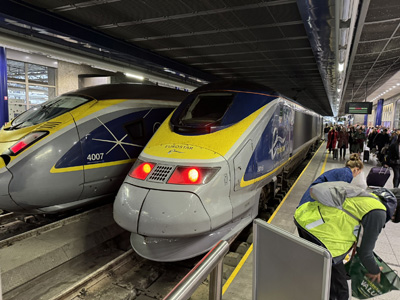
I ate lunch at the Brussels-Midi station, pommes-frites with Andalouse sauce and a chicken brochette. C’est bon et tres Belgique. Then a local train to the airport. The Belgian train system does not follow the example of their German neighbors when it comes to on-time departures. It took me almost an hour of racing around the station to find a train that wasn’t canceled or moved to a distant platform on short notice.
Then my misadventure began. As I rode a shuttle bus to the airport hotel (where the tour starts) I realized that I had obsessed enough shlepping my suitcase up and down train stairs that I left my backpack, with my iPad and a bunch of cash, on the train! So I taxied back to the airport train station (0.7 miles for €15!) and the helpful staff was able to communicate with the train manager. The backpack was heading west, which I could also see in the Find My app tracking my iPad, and they arranged to drop it off in Kortrijk, about 60 miles away. So I bought another train ticket and traveled 90 minutes to retrieve it from another helpful staffer. What a relief! On the trip back we encountered serious delays, including a physical altercation between a conductor and a belligerent Walloon, so much that the train schedule changed and dropped me off at the Brussels Zuid station instead of the airport. I then Ubered to the hotel in a strong rainstorm.
I missed the cocktail reception and the opening bites of dinner, but caught up quickly. Chris Anderson gave a very brief talk about the historic importance of WWI and we adjourned. I also met Chris Tomlin, our tour manager. As this report goes on, I will use the name Chris to refer to Chris Anderson, the historian. The next morning I would meet our bus driver, Klaas.
Tuesday, October 31 — Waterloo
Waterloo is about a half hour drive south of Brussels. Chris gave us an excellent overview of Napoleon’s history and the lead up to this battle. We started at a farm called Belle Alliance, which was approximately the center of the French artillery line, looking north to the Allies’ line on the Mont-Saint-Jean escarpment. Then to a farm called La Haye Sainte, where the first real collision of forces occurred, including an area called the sand pit. Three columns of French attacked here and were repulsed by a big Allied cavalry charge. Then up the minor ridge at the center of Wellington’s line, dominated by a giant mound called Butte de Lion, which was constructed after the battle by reducing the size of the adjoining ridge (much to Wellington’s annoyance). Chris told us about Marshall Ney’s multiple ill-advised heavy cavalry charges, repulsed by British squares, and the failure of Napoleon’s Imperial Guard.
We were let loose for 2.75 hours to visit places on our own and eat lunch. There is a nice museum that is very attractive, has a lot of info on the rise of Napoleon and the lead up to the battle, but is rather light on the actual battle details. I was amused to see that the visitor center had a special exhibition about ABBA. Next door is a giant battle panorama, comparable to the Gettysburg Cyclorama. And the Butte, reached by 226 steps, which I decided to bypass because I judged the staircase to be steep, narrow, and wet. There is actually a very nice diorama map in the visitor center that can almost substitute for the panoramic view from the top, particularly in iffy weather. I could have walked 1200 meters to the Hougoumont farm, but the time didn’t work out for that. A casual restaurant next door served up a nice plate of sausages for me, along with my favorite Belgian beer.
It was about a 90-minute bus ride to Ypres (or Ieper as the Belgians spell it), rather close to where my backpack ended up yesterday. Along the way Chris recounted how important Waterloo was to world history, and how it led to 100 years of (mostly) European peace, but then to WWI. It was a completely decisive battle (unlike any in the Civil War or WWI) that knocked France from its dominant position, promoted the unification and domination of Germany/Prussia, spread revolution across many of the monarchies, and essentially reorganized Europe.
Ypres is a pleasant small town that was rebuilt following its total destruction in WWI. We checked into the Ariane Hotel for two nights. A very nice small hotel, which gets my prize for the first European hotel I have ever encountered in which the myriad of mysterious light switches in the room were actually labeled. And in English! Most of us met Chris for a walk to the downtown market square for dinner on our own. A newly made friend and I ate in a café on the main market square and we both had a delicious Flemish beef stew with pommes frites. I spoke a little French to our very cute waitress and she (humorously) upbraided me for not speaking Flemish; her English was impeccable, of course.
Wednesday, November 1 — Ypres, Belgium
We ventured out early on a cold and blustery day to examine the war-long history of fighting around the outskirts of Ypres. We started at the Essex Farm Cemetery, which was a medical complex and where Canadian Lt Col John McCrae wrote his poem In Flanders Field [the poppies grow…]. We learned some interesting facts about British or Commonwealth cemeteries: this is one of 600 in Europe; all have a giant Crusaders’ Sword/Cross monument and a central altar-type monument; the general grave markers are a similar size and shape as the US markers I’m familiar with, but are carved with details much more elaborately; and as many as half of all the WWI deaths are of the unknown variety. This cemetery had about 1,200 burials. We went to the grave of a rifleman named Valentine Joe Strudwick, age 15, who is believed to be the youngest identified British death of the war.
Next was Langemarck German Cemetery, similar in size to Essex, but interring over 44,000, many in mass graves. Here the grave markers are black, carry as many as eight names each, and are flat to the ground. There was a German attack here in November 1914 (In the first battle of Ypres) that failed, but a myth was perpetrated that it was conducted by untrained university students who pushed forward singing the German national anthem in vain as they died—the “Massacre of Innocents.” This was so powerful that Adolf Hitler himself espoused it, wrote about it in Mein Kampf, and visited the site in 1940. It includes a string of bunkers, which some believe erroneously were coincidently involved in battle, but Chris said that they are fakes, placed there as Nazi propaganda.
At St. Julien, we visited a Canadian memorial overlooked by a large monument called the Brooding Soldier. (Later in the week I was amused to learn that its sculptor, Fred Clemesha, used his own face on the soldier.) Here in April 1915, the second battle of Ypres, was the first use of poison gas (Chlorine) by the Germans on the western front. At nearby Kitcher’s Woods, the Canadians executed a successful counterattack, but took over 6,000 casualties.
Near the small town of Passchendaele, on the ridge that also bears its name, we started discussing the third battle of Ypres, more infamously known as the battle of Passchendaele, July–November 1917. The ridge gradually rises in an arc to the east of Ypres and the Germans had an impregnable defense and a dominant position over the “Ypres Salient.” The Allies eventually gained about 3.5 miles of ground at the cost of 200–300,000 casualties. The Canadian Corps eventually captured the town, with about 100,000 of those casualties, and thus we visited the Canada Gate at Crest Farm commemorating their efforts. We visited the Tyne Cot Cemetery, the largest cemetery for Commonwealth forces anywhere in the world.
We drove back to Ypres for lunch on our own and I had an nice croque madame (which the menu translated as “ham/cheese toastee with fried eggs). Then back up the hill to visit the Passchendaele Museum, which is an excellent collection of artifacts and history info about the infamous third battle. Two unusual highlights were a full scale underground bunker passageway complex as they evolved later in the war and a lengthy outdoor recreation of WWI trenches. There was also supposed to be some kind of immersive battle experience, but it was unfortunately closed for remodeling until February.
On the bus back to the hotel, we watched an episode of the BBC comedy series, Blackadder Goes Forth, set in WWI. Sophomoric, but really funny. Dinner was served in the hotel and about half the group dashed off at 7 PM to walk downtown to the Menin Gate, where every night at 8 they conduct a ceremony called Last Post, commemorating the unknown British and Commonwealth dead, somewhat equivalent to Taps. I didn’t feel like standing around in a crowd in the cold and dark for an hour under a threat of rain, so I watched a few of the many YouTube videos that show the ceremony.
Thursday, November 2 — Arras, France
The weather has turned pretty nasty with a “bomb cyclone” named Ciarán that originated in North America hitting us with some rain, but really heavy winds, like a bitterly cold hurricane. Some gusts found us careering around sidewalks like drunkards. We started today on the Battle of Messines, with British attacks on the Germans southwest of Ypres, May–June 1917, before Passchendaele. We stopped first near Mt Kemmel (Kemmelberg) and discussed British commander Herbert Plumer’s “bite and hold” strategy. In this attack, engineers tunneled and placed 21 giant mines under the lines and on June 7, 19 of them exploded, bringing some success to the British advances along the line. Chris noted that Hitler was a courier on Kemmelberg. Also in this area in 1918 were two American divisions, the 27th and 30th, attached to the British army for the Ypres–Lys Offensive and they suffered the highest casualties of any American units in the war.
Next was Hill 60, which began as a pile of dirt that resulted from railroad construction. This saw significant action in 1914–15 as well as part of the Messines battle in 1917. It was the site of the first mine explosion and became the first area preserved. There is a boardwalk trail through the area, which is pockmarked with still-visible bomb craters. There was a monument to the Australian tunneling company, which was interesting because there were World War II bullet holes in it. Next was Spanbroekmolen Crater, which is now water-filled and called the Pool of Peace. It was the largest of the mine explosions, fueled by 91,000 pounds of ammonal 27 meters under the German line. (Sadly, its detonation was delayed a bit and some advancing British soldiers were killed by falling debris.) In the town of Mesen (Messines), Chris noted that Hitler was treated in the town church for war wounds.
The Island of Ireland Peace Park is new, opened in 1998 to commemorate the joint sacrifices of both the Irish Catholics and Protestants while a virtual civil war divided their families back home. The monument was chartered as part of the Good Friday Accords. Next was a small monument that commemorates the Christmas Truce of 1914, sponsored by a soccer group called UEFA. There was also a small trench replica with elephants—semi conical corrugated iron structures. Next-door was the Prowse Point cemetery, the only one named after an individual soldier.
We bused to the Ploegsteert Memorial, an impressive structure with hundreds of names of fallen soldiers. Churchill served as a battalion commander in the Ploegsteert Woods; British troops called it Plug Street. Back on the bus we enjoyed a nice bag lunch, fittingly with a baguette sandwich. We went to the town of Fromelles, where there was a minor battle on June 19, 1916, part of the battle of the Somme. Thousands of Australians and British were essentially sacrificed to an inadequate battle plan. There is a small museum dedicated to this, which included some small models of trenches and tunnels that were well done. They also had information about the battles of Neuve Chapelle and Aubers Ridge, March and May 1915, respectively. And since Australians were involved, they also included some very minimal information about the Gallipoli campaign.
We drove through the town of Fournes-en-Weppes, where we saw the building in which Corporal Hitler was billeted, 966 rue Faidherbe. This was just a drive-by because the building is privately owned by people who probably do not want the attention. On the bus we watched another episode of Blackadder and started an excellent Canadian/BBC documentary series from 2014 called 14 – Diaries of the Great War.
After a while we reached the city of Arras, where we visited the Carrière Wellington, a museum dedicated to the battle of Arras. Under the city there are extensive limestone quarry caverns that were constructed in the middle ages and people at the time did not know where they were until New Zealand tunnelers happened upon them. (The Wellingham name on this cavern was provided by the Kiwis in honor of their city of that name.) They were greatly expanded with additional tunneling to support the battle plan. As part of the Nivelle Offensive, the French were to make the main attack and the English were tasked with a diversionary attack at Arras. Three armies of English and Canadians hid 24,000 troops underground and swarmed out on April 19, 1917, to attack the German trenches, sometimes only a few yards away from the tunnel exits. Although the attacks achieved complete surprise and were initially successful across much of the line, they soon bogged down and the battle turned into a general failure (as did the main French attack at Chemin des Dames, which we will visit later). The museum was great, including a lengthy tour of the giant caverns 20 meters down, enhanced by a variety of multimedia presentations and a movie that described the actions of the battle. We all got to wear safety helmets that were shaped like British World War I helmets.
We checked into a new hotel, the Arras Mercure, for two nights. Dinner was at the hotel (an excellent piece of beef).
